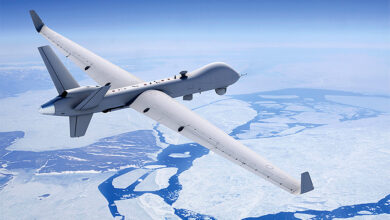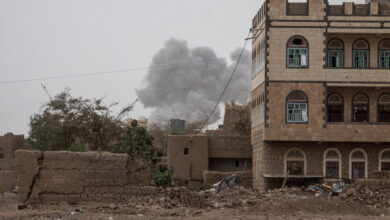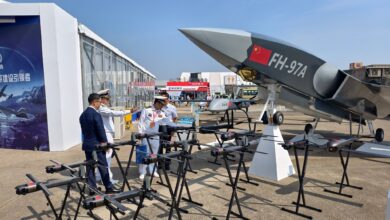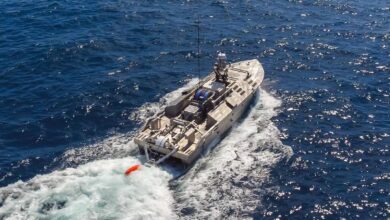US links Saudi Aramco attack to Iran weapons ships seized off Yemen
CENTCOM cited reports by the UN and Conflict Armament Research
A shipment of Iran-made weapons seized by the U.S. Navy off Yemen’s coast in November included components “consistent” with those found at the site of a drone and cruise-missile attack on Aramco oil facilities in Saudi Arabia a month prior, the U.S. Department of Defense said.
The evidence is the latest presented by Washington pointing to Iran’s alleged role in arming the Houthi rebels and apparent involvement in the 2019 oil refinery attacks, which damaged Saudi Arabia’s global daily oil exports in retaliation for Riyadh’s ongoing intervention in its Yemen’s civil war.
The cache of alleged Iranian weapons captured by USS Forrest Sherman included computer systems and vertical gyroscopes “consistent with those found” among debris at the site of the Abqaiq and Khurais oil refinery attacks, Central Command’s chief spokesperson, U.S. Navy Captain Bill Urban, told reporters at the Pentagon on Wednesday, February 19.
The components were also consistent with “numerous” Iranian-made Qassef and Sammad UAVs recovered in Yemen, Urban said.
The announcement echoed a Conflict Armament Research report published hours earlier. Urban cited both the CAR investigation and a January 2020 United Nations report that said Houthi drone components seemed to contain Iranian parts.
Shipping arms to Yemen is a violation of a United Nations arms embargo. The U.S. has sold weapons to and logistically supported a military coalition led by Saudi Arabia to support the Yemeni government against the rebels.
The U.N. has called Yemen’s conflict the world’s worst humanitarian crisis and blamed the Saudi-led air campaign for most civilian deaths, though it has accused all sides, including the Houthis, of possible war crimes.
Houthi fighters claimed to have downed a Saudi-piloted Panavia Tornado fighter jet on Friday, raising concerns that their access to foreign technology may increasingly threaten Riyadh’s air superiority in the stalemated conflict.
The U.S. announced it interdicted another boat in the Arabian Sea earlier this month, which the spokesperson on Wednesday said was carrying 150 Iranian-made Delavieh anti-tank missiles as well as Iran-made 358 surface-to-air missiles.
Both shipments included Iranian-made thermal rifle scopes. The seizure by the USS Forrest Sherman also included 13,000 blasting caps for detonating explosive charges and land-attack cruise missile components, the spokesperson revealed.
Conflict Armament Research has found that improvised explosive devices recovered by security forces in the Gulf island nation of Bahrain contain Iranian-made components also found in Houthi IEDs.
Iran’s government has thoroughly denied arming the Houthis.
The U.S. says it has intercepted six shipments of Iran-made weapons components bound for Yemen since the start of the civil war in 2015. The USS Normandy’s interdiction earlier this month was the second in less than two months.
The crew of the vessel seized in November was turned over to Yemeni authorities after questioning. Electronic equipment was also confiscated, Urban said, declining to say how the U.S. assessed the boat’s destination.
“Sometimes you get lucky, sometimes you make your own luck,” Urban said, adding that the intercepts were “probably a small fraction” of larger shipments.
The spokesperson left open a question whether the U.S. approached Oman’s government about an alleged overland weapons smuggling route through the Gulf kingdom reported by the U.N.
Urban declined to say how the U.S. concluded that the shipments were a result of official Iranian government activity, and refused to comment on intelligence relating to their shipment origin or destination.
“There are certainly indications that the Iranian Quds Force, the IRGC, is a prime part of the weapons transfer,” the spokesperson said on Wednesday.
The U.S. State Department in November accused Abdulreza Shahlaie, an Islamic Revolutionary Guard Corps commander, of assisting Yemen’s Houthi rebels in obtaining Iranian-made weapons.
Asked whether the weapons could have been sent by a third party, Urban responded, “If they were manufactured in Iran, then they came from Iran.”
“There’s not a plausible explanation for how these weapons got onto a vessel … without Iran’s permission.”
Iran’s arms Yemen’s Houthi rebels
A U.N. panel concluded in a January report that Iran provides military and increasing political support to the Houthis.
Iran’s government initially told the U.N. that shoulder-fired anti-tank RPGs seized by the Saudi-led coalition in Aden in 2018 were not of Iranian origin, before admitting that the accompanying optical sights had been previously distributed among Iranian military units.
The U.N. also noted similarities between a UAV engine discovered at the site of the Abqaiq attack and one previously displayed on Iranian TV.
The U.N., Conflict Armament Research and CENTCOM also noted similarities between UAV vertical gyroscopes recovered by Emirati troops from the Houthis in Yemen, found at Abqaiq, in Iraq, and – according to the U.S. – in Afghanistan.
The United Arab Emirates is a part of the Saudi-led coalition against the rebels, who have consolidated control over much of Yemen’s north in opposition to the government of president Abdrabbo Mansour Hadi, who currently lives in exile in Riyadh.
“Some of the components found in [Yemen’s] Houthi UAVs are identical to those identified in Iranian-manufactured UAV’s,” the CAR report read.
“The gyroscopes appear to be of the same make — yet not the same model — as a unit that Saudi authorities recovered following the aerial attack on the Aramco oil facility in Abqaiq, Saudi Arabia” in September 2019, CAR reported.
The U.K.-based organization found that some of the other components of UAV’s recovered in Yemen were manufactured in Europe, and may have been sold to China and Hong Kong before turning up in Iranian-made drones.
UAV engines manufactured by the Germany-based company 3W were “resupplied to a company based in Iran, in violation of German law,” CAR said, citing the earlier U.N. report.
Civilian-made components pass through a series of intermediaries before winding up in Houthi and Iranian-made weapons, the U.N. said, noting that manufacturers may not be aware of the final destination of their products.
More ominously, the CAR report said the Houthis appear to be successfully copying Iranian-made explosive drones and extending their strike range.
“These forces appear to have started producing a hybrid UAV, parts of which are manufactured domestically, rather than utilizing only externally sourced industrial models,” the report read.
CAR also reported that some Houthi UAV components are identical to those used in IEDs used by non-state actors in Bahrain and Yemen, as well as those contained in Iranian UAV’s “and among components seized from the Jihan 1 merchant vessel” seized off Yemen’s coast in 2013.
Though the Houthis claimed credit for the September Aramco attack, U.S. officials have avoided blaming the rebels and instead pointed the finger at Iran.
France, Germany and the U.K. also blamed Iran for the attack, which reduced global daily oil production by roughly five percent.
The U.N. also reportedly concluded the attacks did not originate from the Houthis, but could not confirm the attack was carried from Iran.
Iran’s government thoroughly denied responsibility for the attack. President Hassan Rouhani said the attack was an exercise of Yemen’s “legitimate right of defense.”












